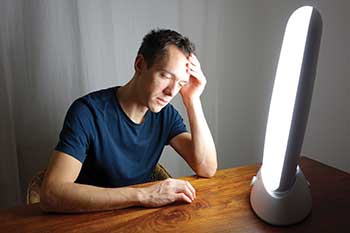It’s a sentiment shared by many in northern latitudes and one most pronounced in people suffering from the winter blues, a type of seasonal affective disorder (SAD). To counter these winter blues, which can make people crave bagels or feel fatigued or depressed, the prescription has long involved sitting before a fluorescent white light box rated at 10,000 lux for a period of 15 to 30 minutes each morning throughout the season.
However, a pair of studies published last fall show thoughts can be just as powerful as — and longer lasting than — light in countering the winter blues. These studies’ findings about the short- and long-term impacts of cognitive-behavioral therapy (CBT) on people suffering from the winter blues could pose serious challenges to the light box industry and spur innovation within it.

Recent studies show that cognitive-behavioral treatment tailored for seasonal affective disorder (CBT-SAD) and light therapy are ‘comparably effective treatment modalities’ for combating the winter blues. Devices that are more convenient to use or that provide a luxurious experience may help the light box industry maintain an advantage over CBT-SAD.
Even though the first light box research therapy study was conducted in 1984 and more than 60 controlled studies have been published since then, according to light box maker Carex Health Brands in Norwell, Mass., the exact impacts of this technology on the brain remains speculative. The light boxes may affect the pineal gland, suppressing the secretion of sleep-inducing melatonin and increasing levels of energy-providing serotonin. Alternatively, the light boxes may correct people’s daily body clock, referred to as their circadian rhythm, which is disturbed by the shorter winter days and decreased exposure to natural light.
In a multiyear study published last November in the American Journal of Psychiatry, a research team led by University of Vermont psychological sciences professor Kelly J. Rohan showed that people suffering from the winter blues were more prone to experience depression again and more severely over the long-term than those who received CBT tailored for the winter blues.
Rohan said that depression recurrence over the long-term may be higher for people who receive light therapy because some may stop using their light boxes. She noted that the daily, 30-minute commitment required by light therapy throughout each winter is too onerous for some people. CBT for the winter blues, in contrast, only required two 90-minute sessions per week over a six-week period.

The light box industry could end up losing market share among its core winter blues base if medical practitioners embrace Rohan’s CBT recommendation and customers find her less time-consuming treatment alterative more appealing. Light box industry experts said the high costs of CBT may make this outcome unlikely. However, with talk therapy and light therapy now looking “comparably powerful,” Rohan said engineers must now find a way to conveniently, effectively and safely deliver 10,000 lux to people suffering from the winter blues. She said past industry attempts to do this have fallen short.
“It’s kind of boring just sitting in front of a light box,” said Darius Michael, a sales and marketing manager with SunSauna in Kirkland, Wash.
Companies like SunSauna have approached this issue by making light therapy a luxurious experience. SunSauna has developed portable saunas that distribute near-, mid- and far-infrared heat, along with a full-spectrum neodymium light that delivers over 10,000 lux.
Other companies utilize LED technology to create smaller light box units. Northern Light Technologies in Montreal offers a visor that fits to the underside of a baseball cap and is equipped with green LEDs that emit 8,000 to 12,000 lux. However, President Steven Nador said he believes larger units will dominate the market in the coming decades.
“If they’re not committed to using it every day, you could see a reverse effect,” Alaska Northern Lights Marketing Director Jessica Loggins said of therapy with a traditional fluorescent light box.
Based in Reno, Nev., Alaska Northern Lights began offering a traditional, bulky fluorescent light box in 1993, but in 2011 it started offering a compact, 5.25 × 7.5-in. light therapy lamp called an Aurora LightPad Mini. This device weighs about a half-pound and uses 180 LEDs to deliver 10,000 lux at 25 inches. When it comes to Alaska Northern Lights’ traditional light boxes, Loggins said the company encourages customers to incorporate light therapy into their morning routines.
As Einstein proved, only the speed of light — not time — is constant. The amount of time people have to devote to light therapy will vary throughout their lives.
“To remove some of that burden would be revolutionary,” said Rohan.